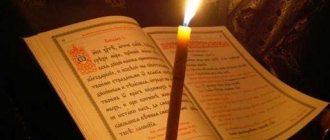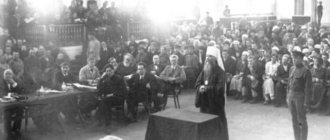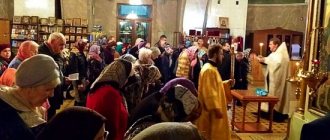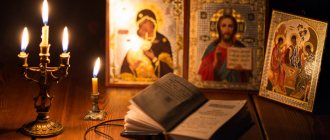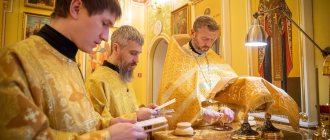The concept and meaning of the akathist in Orthodoxy
An akathist is a church hymn to the Lord, the Mother of God, and the saints, sung while standing. The tradition of singing songs of praise originated in ancient Greece during the Byzantine period. The first song prayer known to this day is the Great Akathist to the Most Holy Mother of God.
It was written after the siege of Constantinople in 626. An eyewitness to the siege, Sinkell, claimed that the Holy Virgin showed her power by intervening in the battle at sea. The barbarians on the boats crashed near the Blachernae Church of the Theotokos.
After divine deliverance from the barbarian raid, the emperor of the Eastern Roman Empire considered the Mother of God to be the Patroness of his capital. The prayer service was performed in the Blachernae Church, where the miraculous icon of the Holy Virgin, her belt and robe were kept. Subsequently, the ritual spread to the entire Orthodox Church.
Subsequent chants were composed by analogy with the original model, which made the hymn a special genre, a form of church poetry. A poetic text has a special structure. It includes 25 songs arranged in the Greek alphabet.
There is a main kontakion, which has a specific ending or chorus, and 12 kontakia interspersed with ikos. At the end of each ikos, “Rejoice!” is said, and the kontakia ends with “Hallelujah!” The 13th Kontakion is repeated three times, then the first Irmos is sung.
The authors of the texts were theologians, holy fathers, and Orthodox poets. In the Russian Orthodox Church, hymns are written not only for the Mother of God, Jesus Christ, but also for each glorified saint, as well as for some holidays. The first Russian solemn prayer was dedicated to Sergius of Radonezh.
The peculiarity of performing the hymn is that it can be performed at home, without a priest or choir.
The history of the song of praise to the Mother of God - the intercessor of Constantinople
The Church Charter provides for the execution of only one type of akathist - the Great:
- It was dedicated to the Mother of God and written during the reign of the Byzantine emperor Heraclius in the first quarter of the 7th century on the occasion of the miraculous liberation of the city from the siege of enemies, where she was the protector and patroness of the townspeople. After the victory, her image was written on the gate and the Great Akathist “To the Chosen Voivode...” was composed;
- It is performed annually only during Great Lent (on Akathist Saturday), and is called the Praise of the Mother of God;
- At first, this term denoted the name of a specific work, but later in Russia it began to be used to refer to all poetic church songs of praise, that is, it began to denote a literary genre. A tradition has developed of composing akathists in honor of every saint (including new ones), which, however, did not make their presentation as a whole worthy of the first (classical) akathist. The famous theologian Cyprian (Kern) thinks so.
This theme is also developed in the story by A.P. Chekhov's "Holy Night".
When to read the akathist correctly at home
The Charter of the Orthodox Church obliges the sung of the akathist on Saturday of the fifth week of Great Lent (other solemn hymns are prohibited during Great Lent). Sometimes solemn prayers are sung at matins or a prayer service in honor of some holiday. In other cases, singing a solemn hymn in honor of Jesus Christ, the Mother of God, or some saint is the work of a believer; there are no other rules.
Reading the akathist is a spiritual strain that not every believer can withstand. To strengthen your strength, you should ask for a blessing from your confessor.
The prayer is read in a special order.
Before beginning the hymn, the following prayers should be read:
- "In the name of the Father and the Son and the Holy Spirit, Amen."
- (Prayer of the Publican from the Gospel of Luke). “God, be merciful to me, a sinner.” (Bow).
- (Pre-initial). “Lord Jesus Christ, Son of God, prayers for the sake of Your Most Pure Mother, our reverend and God-bearing fathers and all the saints, have mercy on us. Amen. Glory to Thee, our God, glory to Thee.”
- "To the Holy Spirit."
- "Trisagion" It is pronounced 3 times, with the sign of the cross and a bow from the waist.
- "Holy Trinity". (“Lord, have mercy” is read 3 times).
- "Our Father".
- "Virgin Mother of God, rejoice."
- “Lord, have mercy” (12 times).
- “Come, let us worship our God the King (Bow). Come, let us worship and fall down before Christ, our King God. (Bow). Come, let us bow and fall down to Christ Himself, the King and our God” (Bow).
- Psalm 50.
- "Symbol of faith".
The initial prayers change from Easter to Ascension; instead of addressing the Holy Spirit, they read: “Christ is risen from the dead, trampling down death by death, and giving life to those in the tombs.” (Repeat 3 times). From Ascension to Trinity the text is not read.
After the introduction, the reading of the anthem begins. The prayer ends with an appeal to the Most Holy Theotokos:
“It is worthy to eat, for truly to bless You, Theotokos, Ever-Blessed and Most Immaculate and Mother of Our God. The most honorable Cherub and the Most Glorious without comparison Seraphim, who without corruption gave birth to God the Word, the real Mother of God, we magnify You.”
Then follows:
- “Glory to the Father and the Son and the Holy Spirit, now and ever and unto ages of ages. Amen".
- “Lord, have mercy” (3 times).
- “Lord Jesus Christ, Son of God, prayers for the sake of Your Most Pure Mother, our reverend and God-bearing fathers and all the saints, have mercy and save me, a sinner, as I am Good and Human darling. Amen".
Options if the appeal was to a saint, the Cross of the Lord or an angel:
- “Lord Jesus Christ, Son of God, prayers for the sake of Your Most Pure Mother, our reverend and God-bearing fathers, the saint (the name of the saint to whom the akathist was read), have mercy and save me, a sinner, as Good and Lover of Mankind. Amen".
- “By the power of the Honest and Life-giving Cross, have mercy and save me, a sinner, as I am Good and Lover of Mankind. Amen".
- “Honest Heavenly Powers of the Bodiless, have mercy and save me, a sinner, as you are Good and Lover of Humanity. Amen".
The prayer service ends with the sign of the cross and a bow from the waist.
Features of independent reading
As we have already mentioned, it is not at all necessary to go to church every time a person feels the need to read an akathist, because he can do this even at home. The peculiarity of this type of hymn of praise is that it must be read while standing (after all, “akathist” is translated from Greek as “non-saddle singing”).
In addition, the reader should look at the icon to which he offers his prayers, or which depicts the saint to whom praise is intended.
It is also worth noting that although the akathist is characterized primarily as a chant, you do not have to sing it - just read it as a prayer.
Thus, in order to independently perform the akathist, all that is required is faith in God and the saints, and adherence to the correct order of reading ikos and kontakia. If you do this with a pure heart, the saints will listen to your prayers and help you find the right path.
If you find an error, please select a piece of text and press Ctrl+Enter.
Schedule by days of the week
In home worship, it is customary to adhere to the church rule: during the week, remember the same events and saints as in church.
Monday
On the first day of the week, the Heavenly protectors (personal and all-Christian) are commemorated. The Akathist is sung either to the Guardian Angel or to the Archangel Michael.
Tuesday
The next day, they remember John the Baptist, the predictor of the coming of the Savior, who called on the Jews to repent of their sins. In the solemn hymn, the prophet is praised as the forerunner of Christ in earthly life and hell, introducing the rite of baptism by water, baptizing Jesus in the Jordan River.
Wednesday
In the middle of the week, an akathist is sung in honor of Jesus (the Sweetest Jesus) or the Mother of God. The hymns are dedicated to the life of Christ and the memory of the Blessed Virgin.
Thursday
On this day, they solemnly commemorate the closest disciples of Jesus Christ, Peter and Paul, as well as their successors in the spread of Christianity: Nicholas the Wonderworker and the holy apostles.
Friday
Friday is the day when Christ was crucified on the cross. They read an akathist dedicated to the suffering of Jesus on the cross and the miraculous Cross of the Lord.
Saturday
On Saturday they sing the hymn to the Council of New Martyrs and Confessors of the Russian Church or the Mother of God. The meaning of the akathist is the remembrance of all the departed.
Sunday
On Sunday they sing a hymn in remembrance of the Resurrection of Christ.
What is the difference between a canon and an akathist?
Even though they are both hymns of praise , their order and meaning are not exactly the same:
- The canon has two meanings: the rules and norms of church life or the genre of chants in which the Lord, the Mother of God and the saints are glorified;
- The order of singing the canons is determined by the Church Charter and occurs every day. In contrast, the akathist, which, as we already know, is not spelled out in this document, is read only upon orders from parishioners during a prayer service;
- The canons contain mostly 8 songs. Inside, each of them is divided into irmos (first stanza) and troparia. The number of the latter is, as a rule, 2-6, but sometimes up to thirty (in the “special” canon). Each one is brief, but together they explain the essence of the holiday or the life and feat of the saint. Irmos set the metric meter of songs. They are usually sung and troparia read.
- Unlike akathists, several canons can be performed simultaneously. The latter also belong more likely to the category of penitential genres, in contrast to laudatory akathists.
The texts of the canons belong to the pen of priests, while the akathists can be authored by anyone.
List of Orthodox akathists
The Orthodox prayer book contains a list of all the akathists of the Russian Orthodox Church.
Mother of God
Akathists of the Mother of God are read in honor of her icons:
- "Unexpected joy." Thanks for the miraculous healing.
- "Inexhaustible Chalice" They ask to be cured/cured from the vice of drunkenness and drug addiction.
- "The Queen of All." They ask for help with cancer, problems with naughty children.
- "Tenderness." Prayer of thanksgiving.
- "Healer" They pray in front of the icon for deliverance from serious illnesses.
- "Quick to Hear." The holy image is located on Mount Athos. Miraculous power was manifested when dealing with painful conditions.
- "Joy to all who mourn." Prayer of thanksgiving.
- "Upbringing". Parents who want to find a common language with their children receive effective help.
- "Mammal". Pregnant women turn to the icon asking for a safe birth and healthy babies.
- "Burning bush". The Mother of God will help you escape from a fire and avoid illegal persecution.
- "Kazanskaya". At home, they offer her prayers to save the marriage and cure her blindness.
- "Protection of the Most Holy Theotokos." At home they pray at the icon to strengthen their faith.
- "Quiet my sorrows." The Akathist is read in front of the holy image when one is overcome by everyday adversity.
- "Softening Evil Hearts." They pray to the icon when children quarrel with their parents.
An appeal to the Mother of God pacifies the believer’s soul and gives hope for healing or a solution to a problem.
Angels and Saints
Angels and saints to whom you can serve a prayer service with the reading of the akathist at home:
- Spyridon of Trimifuntsky;
- John the Baptist;
- archangel Michael;
- noble princes Peter and Fevronia of Murom;
- St. George the Victorious;
- Panteleimon the Healer;
- John the Warrior;
- Tikhon of Voronezh Zadonsky;
- Alexander Svirsky;
- Nicholas the Wonderworker;
- Matrona of Moscow;
- Luke of Simferopol;
- Vasily Ostrogsky;
- Elizaveta Alapaevskaya;
- John of Kronstadt;
- Seraphim of Sarov;
- Ksenia Petersburgskaya;
- Council of New Martyrs and Confessors of the Russian Church;
- Harlampy of Magnesia;
- John Chrysostom;
- martyrs Faith, Hope, Love and their mother Sophia;
- Innocent of Moscow;
- Sergius of Radonezh;
- Hieromartyr Cyprian and Martyr Justina;
- Alexy Moskovsky;
- Alexander Nevskiy;
- Catherine of Alexandria;
- Varvara Iliopolskaya;
- Boniface of Tarsus.
The Akathist is sung on any day of the week, at morning or evening prayer.
